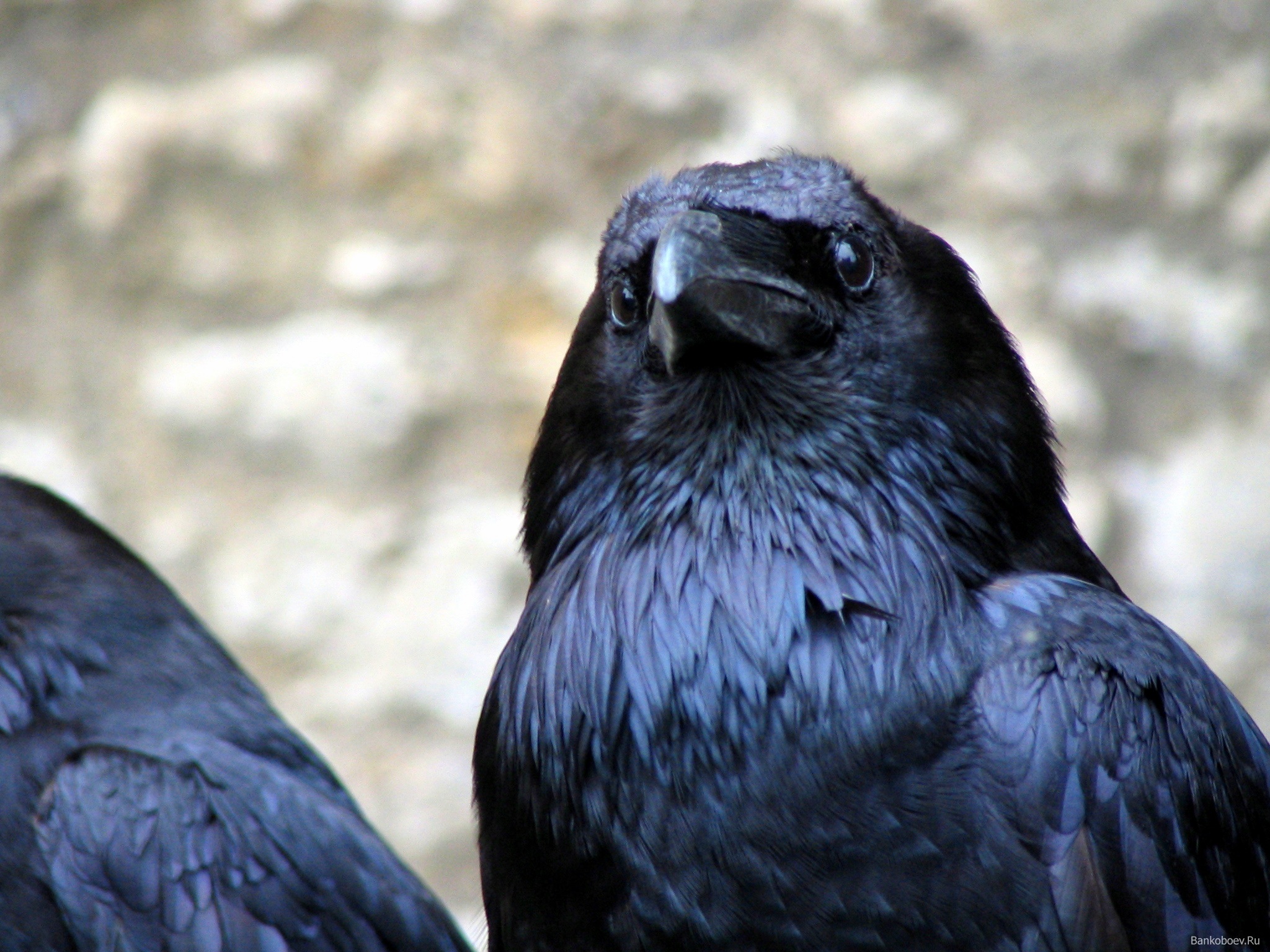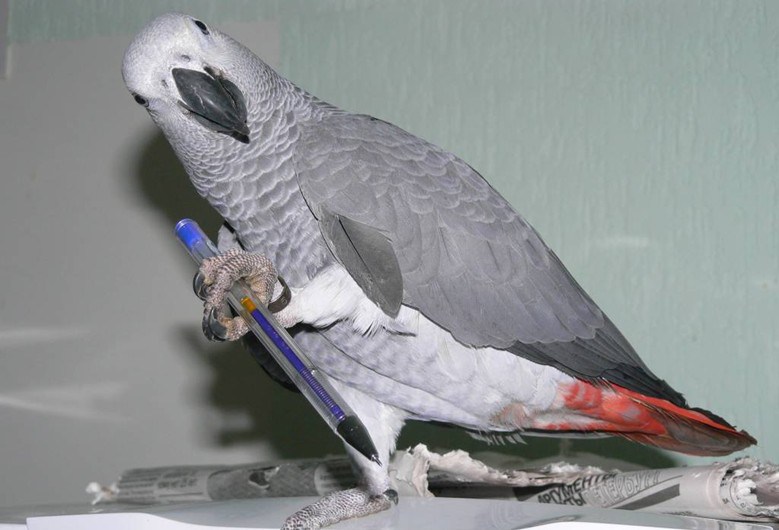Where do the corvids and parrots get cognitive abilities? Recent research by scientists
The density of neurons in the brain regions of corvids and parrots responsible for cognitive abilities, as the results of recent studies have shown, exceeds the density of neurons in the brain of primates. We will tell you more about this unexpected discovery in today's publication.

The cleverness of ravens and parrots is an axiom, confirmed both by observations of the scientific community and the personal experience of feathered owners. And parrots and crows, as you know, have the ability to memorize and pronounce human speech and quite rationally use tools. Gray crows sometimes demonstrate incredible intellectual abilities in a variety of situations. They were seen in the winter, riding down like sledges in the aluminum pan covers found somewhere from snow-covered roofs, they with obvious enthusiasm tease dogs and cats by grabbing their tails. They soak bread crusts in a puddle, store food and even learn to intentionally throw under the wheels of cars that they are not able to peck. They most incredibly recognize people “in person” regardless of what clothes they wear and easily distinguish a gun from a stick, “cooperate” with each other during joint adventures, for example, they “work” together, stealing eggs from nests: one crow drives a bird from its nest, and the other picks up eggs. Extensive scientific publications are devoted to the cognitive abilities of these amazing birds, as well as the abilities of some parrot species, and, of course, such obvious signs and a variety of manifestations of intelligence need some explanation.

One of the greatest wiseacles in the animal world is the Jaco, or African Gray Parrot.
Interestingly, in the scientific world, interest in the "extraordinary" abilities of some representatives of birds arose when biologists and anthropologists seriously thought about the ways of development of human intelligence. It is clear that intellect could not come out of nowhere, it should have had some kind of “source” in the evolutionary past. First of all, they began to search for such a source, of course, from primates. But, taking into account the above examples of manifestations of “superpowers”, demonstrated by jays, crows, magpies, cockatoo, Jaco and some other representatives of birds, standing on the evolutionary step much further from humans than higher primates, attempts to find an explanation of the origin became much more interesting for scientists their cognitive abilities.
What turned out? The brain of birds includes several fields with distributed functions. Each field consists of structural components - glia, neurons and neuroglial complexes. A neuron, as we know, transmits information, glia helps it, and the neuroglial complex, analyzes information, as the cell columns of the mammalian cortex do. (The column is represented by a group of neurons located in the neocortex of the brain perpendicular to its surface and combines the nerve cells of different layers of the cortex.)
How can we explain the presence of cognitive abilities in these birds, because if you focus on the size of the brain relative to the size of the body and the total number of neurons, then naturally they won’t be able to compete with primates, and the developed new cortex, which determines the presence of cognitive abilities of a number of animal representatives they also lack peace.
Studies conducted in this direction have revealed: part of the functions performed by the cerebral cortex in mammals in birds is taken over by the striatum (striatum). Historically, the striatum is one of the oldest parts of the brain, which is why the scientific community is skeptical of its cognitive abilities, which are formed by the new mammalian cortex. And, nevertheless, it was in some representatives of the family of feathered striatums that turned out to be unexpectedly difficult in structure.
If we compare the representatives of the overwhelming number of species of birds, like a pigeon, with recognized "intellectuals", such as ravens, it turns out that the specific density of neurons in the brain of a raven is twice as high. The crows themselves (both neurons and auxiliary glial cells) are smaller in the raven, but the intercellular neuroglial complexes responsible for the speed of operational processing of information are highly developed and much larger.
It is worth adding that the effectiveness of brain activity is determined not only by the number and area of neurons, glia and neuroglial complexes, but also by their mutual orientation in space (a kind of hierarchical structure), which determines the ability of neurons to "communicate" with each other. The relative position of brain cells with some correction can be characterized by the distance between an arbitrary pair of the closest cells. The average distances between cells form the so-called “cell proximity matrix”, which is different for each studied brain area. Such a matrix is an excellent tool for assessing the structure of the brain and the potential of cognitive abilities.
Such a comparison was made among representatives of birds, and how competitive is the brain of a raven or, for example, a parrot, in comparison with primates? Scientists from Charles University in Prague and their colleagues from the University of Vienna and Vanderbilt University conducted large-scale studies, during which they compared the number of neurons in the brain of a number of representatives of the animal world and 28 bird species. The results put the researchers in a state of shock. As it turned out, in parrots, crows and songbirds, the specific density of neurons is twice that of monkeys and four times that of rodents. More detailed research results can be found on the PNAS pages.
The apparent discrepancy is explained simply: as you know, it is generally accepted that the larger the size of the neuron, the more contacts it can form with other cells. Therefore, the larger the brain’s volume, the more large neurons you can “fit” into it, which means the more neural chains to realize and the higher cognitive abilities to obtain. Like primates, some birds also have large neurons, but in much smaller quantities per unit volume. But the epicenter, which allows not only to realize cognitive abilities, but also in certain respects to excel primates in this respect, is concentrated in a structure called the “cloak” of the finite or large brain.
Compared to mammals, ravens, parrots, and some other representatives of the feathered kingdom have a pronounced tendency: instead of large neurons that provide cognitive abilities, the cloak has many neurons that are small, rigidly structured, and provide the same function. The structural components of the crow's brain are located closer to each other, which accelerates and optimizes the functioning of the nerve chains. If in mammals in the evolutionary series the density of cellular elements decreases, then in birds it increases, including due to the combination of single neurons and glia in the aforementioned into rather complex neuroglial complexes.
According to studies, the density of neurons located in parrots and corvids predominantly in the local area of the finite brain and directly involved in the process of supporting cognitive functions, these representatives of birds overtook the monkeys.
The next step that scientists intend to take is an attempt to find out if there are any unique features in the work of these miniature neurons, combined into separate target block zones. Researchers suspect that there are many surprises here, because the principles of organizing and transmitting information implemented between adjacent shortened nerve chains - “neural blocks” in birds should look completely different than those that realize much larger and simpler organized neurons in And now it’s hard to rule out the possibility that, despite different brain volumes and a lower total number of neurons, a raven’s brain will be more perfect than a chimpanzee’s brain. ie in the course of research, as well as principles of organization of the brain,
That's all, with you there was a simple service for choosing complex Dronk.Ru equipment . Do not forget to subscribe to our blog , there will be many more interesting things ...


The cleverness of ravens and parrots is an axiom, confirmed both by observations of the scientific community and the personal experience of feathered owners. And parrots and crows, as you know, have the ability to memorize and pronounce human speech and quite rationally use tools. Gray crows sometimes demonstrate incredible intellectual abilities in a variety of situations. They were seen in the winter, riding down like sledges in the aluminum pan covers found somewhere from snow-covered roofs, they with obvious enthusiasm tease dogs and cats by grabbing their tails. They soak bread crusts in a puddle, store food and even learn to intentionally throw under the wheels of cars that they are not able to peck. They most incredibly recognize people “in person” regardless of what clothes they wear and easily distinguish a gun from a stick, “cooperate” with each other during joint adventures, for example, they “work” together, stealing eggs from nests: one crow drives a bird from its nest, and the other picks up eggs. Extensive scientific publications are devoted to the cognitive abilities of these amazing birds, as well as the abilities of some parrot species, and, of course, such obvious signs and a variety of manifestations of intelligence need some explanation.

One of the greatest wiseacles in the animal world is the Jaco, or African Gray Parrot.
Interestingly, in the scientific world, interest in the "extraordinary" abilities of some representatives of birds arose when biologists and anthropologists seriously thought about the ways of development of human intelligence. It is clear that intellect could not come out of nowhere, it should have had some kind of “source” in the evolutionary past. First of all, they began to search for such a source, of course, from primates. But, taking into account the above examples of manifestations of “superpowers”, demonstrated by jays, crows, magpies, cockatoo, Jaco and some other representatives of birds, standing on the evolutionary step much further from humans than higher primates, attempts to find an explanation of the origin became much more interesting for scientists their cognitive abilities.
What turned out? The brain of birds includes several fields with distributed functions. Each field consists of structural components - glia, neurons and neuroglial complexes. A neuron, as we know, transmits information, glia helps it, and the neuroglial complex, analyzes information, as the cell columns of the mammalian cortex do. (The column is represented by a group of neurons located in the neocortex of the brain perpendicular to its surface and combines the nerve cells of different layers of the cortex.)
How can we explain the presence of cognitive abilities in these birds, because if you focus on the size of the brain relative to the size of the body and the total number of neurons, then naturally they won’t be able to compete with primates, and the developed new cortex, which determines the presence of cognitive abilities of a number of animal representatives they also lack peace.
Studies conducted in this direction have revealed: part of the functions performed by the cerebral cortex in mammals in birds is taken over by the striatum (striatum). Historically, the striatum is one of the oldest parts of the brain, which is why the scientific community is skeptical of its cognitive abilities, which are formed by the new mammalian cortex. And, nevertheless, it was in some representatives of the family of feathered striatums that turned out to be unexpectedly difficult in structure.
If we compare the representatives of the overwhelming number of species of birds, like a pigeon, with recognized "intellectuals", such as ravens, it turns out that the specific density of neurons in the brain of a raven is twice as high. The crows themselves (both neurons and auxiliary glial cells) are smaller in the raven, but the intercellular neuroglial complexes responsible for the speed of operational processing of information are highly developed and much larger.
It is worth adding that the effectiveness of brain activity is determined not only by the number and area of neurons, glia and neuroglial complexes, but also by their mutual orientation in space (a kind of hierarchical structure), which determines the ability of neurons to "communicate" with each other. The relative position of brain cells with some correction can be characterized by the distance between an arbitrary pair of the closest cells. The average distances between cells form the so-called “cell proximity matrix”, which is different for each studied brain area. Such a matrix is an excellent tool for assessing the structure of the brain and the potential of cognitive abilities.
Such a comparison was made among representatives of birds, and how competitive is the brain of a raven or, for example, a parrot, in comparison with primates? Scientists from Charles University in Prague and their colleagues from the University of Vienna and Vanderbilt University conducted large-scale studies, during which they compared the number of neurons in the brain of a number of representatives of the animal world and 28 bird species. The results put the researchers in a state of shock. As it turned out, in parrots, crows and songbirds, the specific density of neurons is twice that of monkeys and four times that of rodents. More detailed research results can be found on the PNAS pages.
The apparent discrepancy is explained simply: as you know, it is generally accepted that the larger the size of the neuron, the more contacts it can form with other cells. Therefore, the larger the brain’s volume, the more large neurons you can “fit” into it, which means the more neural chains to realize and the higher cognitive abilities to obtain. Like primates, some birds also have large neurons, but in much smaller quantities per unit volume. But the epicenter, which allows not only to realize cognitive abilities, but also in certain respects to excel primates in this respect, is concentrated in a structure called the “cloak” of the finite or large brain.
Compared to mammals, ravens, parrots, and some other representatives of the feathered kingdom have a pronounced tendency: instead of large neurons that provide cognitive abilities, the cloak has many neurons that are small, rigidly structured, and provide the same function. The structural components of the crow's brain are located closer to each other, which accelerates and optimizes the functioning of the nerve chains. If in mammals in the evolutionary series the density of cellular elements decreases, then in birds it increases, including due to the combination of single neurons and glia in the aforementioned into rather complex neuroglial complexes.
According to studies, the density of neurons located in parrots and corvids predominantly in the local area of the finite brain and directly involved in the process of supporting cognitive functions, these representatives of birds overtook the monkeys.
The next step that scientists intend to take is an attempt to find out if there are any unique features in the work of these miniature neurons, combined into separate target block zones. Researchers suspect that there are many surprises here, because the principles of organizing and transmitting information implemented between adjacent shortened nerve chains - “neural blocks” in birds should look completely different than those that realize much larger and simpler organized neurons in And now it’s hard to rule out the possibility that, despite different brain volumes and a lower total number of neurons, a raven’s brain will be more perfect than a chimpanzee’s brain. ie in the course of research, as well as principles of organization of the brain,
That's all, with you there was a simple service for choosing complex Dronk.Ru equipment . Do not forget to subscribe to our blog , there will be many more interesting things ...

 |  |  |
| Why do online stores give money for purchases? | Save up to 8% on every purchase on AliExpres and other online stores in China | Get your money back - Choose a cashback service for Aliexpress |
